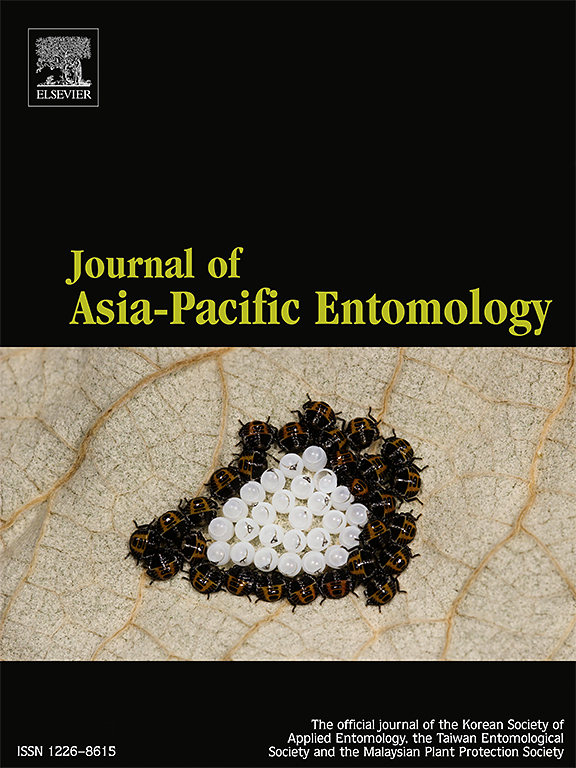化学农药与杀虫细菌对夜蛾的联合毒力及防效研究
IF 1.3
3区 农林科学
Q3 ENTOMOLOGY
引用次数: 0
摘要
秋粘虫(Spodoptera frugiperda, J.E. Smith)是一种全球流行的害虫,对多种作物构成重大威胁。然而,由于长期过量使用单一农药,导致一虫对多种农药产生抗药性。本研究对两种复合农药的9种不同组合进行了研究。Metaflumizone (MFZ)与Empedobacter brevis联用、Emamectin benzoate (EMB)与Bacillus thuringiensis G033A联用对FAW的防治均表现出显著的协同效应,其毒性协同系数(CTC)均大于120。当短叶螨推荐剂量减少50%,MFZ推荐剂量分别减少25%和50%时,复合农药对FAW的田间防治效果仍保持较高水平(第7天达80%以上)。同样,当苏云金芽孢杆菌G033A推荐剂量减少50%,EMB推荐剂量分别减少25%和50%时,对FAW的田间防治效果也很高(第7天达到70%以上)。然而,当MFZ和EMB的减少量超过推荐剂量的75%时,混合物的协同作用也开始下降。我们的研究表明,将化学农药和生物工程细菌的剂量各减少50%是可行的。MFZ与短弧菌、EMB与苏云金弧菌G033A组合可有效防治一叶枯病。本文章由计算机程序翻译,如有差异,请以英文原文为准。

Joint toxicity and control efficacy of chemical pesticides and insecticidal bacteria against Spodoptera frugiperda (Lepidoptera: Noctuidae)
The fall armyworm (FAW), Spodoptera frugiperda (J.E. Smith), is a globally prevalent pest, posing a substantial threat to a wide range of crops. Nevertheless, the long-term and excessive application of single pesticides has led to the development of resistance to multiple pesticides in FAW. In this study, nine different combinations of two compound mixed pesticides were investigated. The combinations of Metaflumizone (MFZ) with Empedobacter brevis, and Emamectin benzoate (EMB) with Bacillus thuringiensis G033A all demonstrated significant synergistic effects in the control of FAW, with their Coefficient of Toxicity Collaboration (CTC) all surpassing 120. When the recommended dose of E. brevis was reduced by 50%, and the recommended dose of MFZ was decreased by 25%, and 50% respectively, the compound pesticides still maintained high field control efficacy against FAW (over 80% on the 7th day). Similarly, when the recommended dose of B. thuringiensis G033A was reduced by 50%, and the recommended dose of EMB was decreased by 25%, and 50%, respectively, high field control efficacy against FAW was also achieved (over 70% on the 7th day). Nevertheless, when the reduction of MFZ and EMB exceeded 75% of the recommended dose, the synergistic effect of the mixture also began to decline. Our research indicates that it is feasible to reduce the doses of both chemical pesticides and bioengineered bacteria by 50% each. The combinations of MFZ and E.brevis, as well as EMB and B. thuringiensis G033A, can be effectively applied for the control of FAW.
求助全文
通过发布文献求助,成功后即可免费获取论文全文。
去求助
来源期刊

Journal of Asia-pacific Entomology
Agricultural and Biological Sciences-Insect Science
CiteScore
2.70
自引率
6.70%
发文量
152
审稿时长
69 days
期刊介绍:
The journal publishes original research papers, review articles and short communications in the basic and applied area concerning insects, mites or other arthropods and nematodes of economic importance in agriculture, forestry, industry, human and animal health, and natural resource and environment management, and is the official journal of the Korean Society of Applied Entomology and the Taiwan Entomological Society.
 求助内容:
求助内容: 应助结果提醒方式:
应助结果提醒方式:


